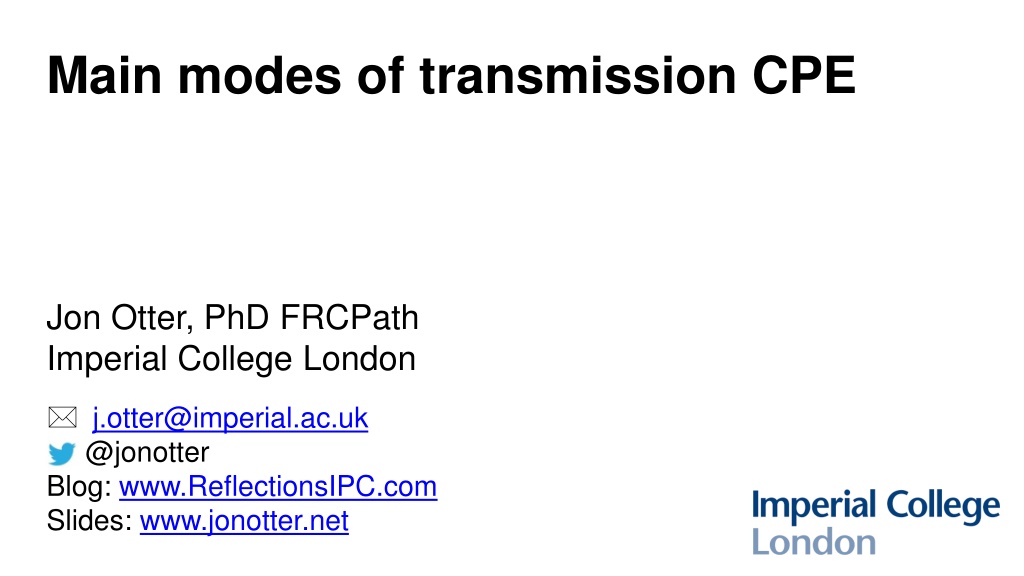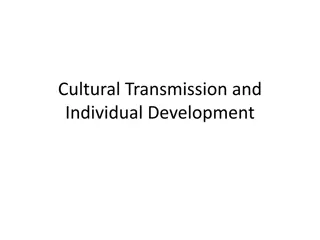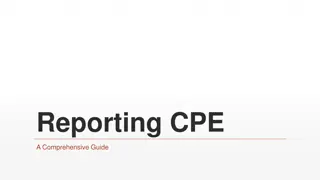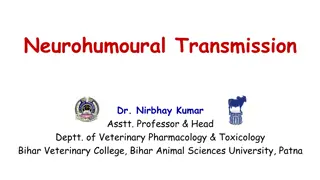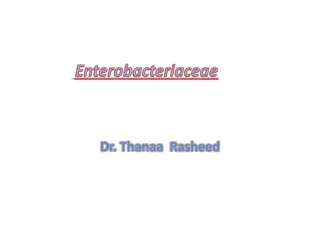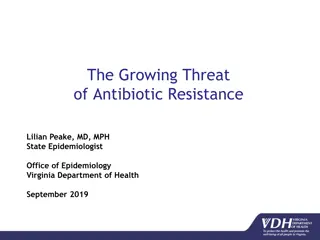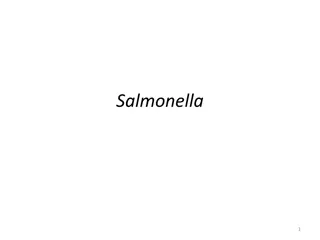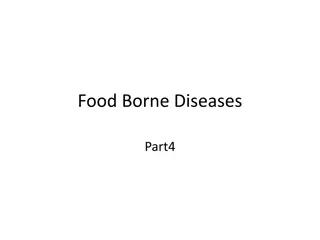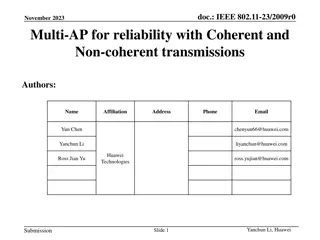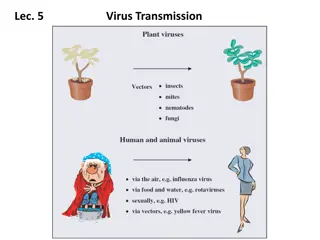Understanding the Transmission of Carbapenemase-Producing Enterobacteriaceae (CPE)
This content delves into the main modes of transmission of Carbapenemase-Producing Enterobacteriaceae (CPE) by presenting images and information from various studies. It covers key topics such as rapid spread, CPE in Europe, emergence of CPE in the UK, transmission modes, contaminated hands and surfaces, challenges in medical device decontamination, contaminated sinks and drains, and the possible airborne nature of CPE. The content emphasizes the critical importance of effective infection control measures to combat the spread of CPE.
Download Presentation

Please find below an Image/Link to download the presentation.
The content on the website is provided AS IS for your information and personal use only. It may not be sold, licensed, or shared on other websites without obtaining consent from the author. Download presentation by click this link. If you encounter any issues during the download, it is possible that the publisher has removed the file from their server.
E N D
Presentation Transcript
Main modes of transmission CPE Jon Otter, PhD FRCPath Imperial College London j.otter@imperial.ac.uk @jonotter Blog: www.ReflectionsIPC.com Slides: www.jonotter.net
Rapid spread Clinical impact CPE AMR
CPE in Europe, 2016 % invasive K. pneumoniae isolates resistant to carbapenems EARS-Net 2018.
Emergence of CPE in the UK ESPAUR 2017.
Transmission modes Otter et al. Infect Control Hosp Epidemiol 2011;32:687-699.
Contaminated hands 40% Erasmus et al. Infect Control Hosp Epidemiol 2010;31:283-94.
Contaminated surfaces Mitchell et al. J Hosp Infect 2015;91:211-217.
When medical device decon fails 39 patient CRE outbreak in 2013 in Illinois.1 Odds ratio for duodenoscope exposure in case patients 78 (95% CI 6-1008). No breakdown in compliance with decon procedures; has prompted a global review and change in the way that these devices are decontaminated.2 Meticulously cleaning duodenoscopes prior to high-level disinfection should reduce the risk of transmitting infection, but may not entirely eliminate it. (FDA Feb 23 2015). 1. 2. Epstein et al. JAMA. 2014;312:1447-55. Rutala & Weber. Am J Infect Control 2016;44 (Suppl):e47-51
Contaminated sinks / drains CPE (K. pneumoniae) acquisition and clinical infection halved through improved management of sinks (OR = 0.51 for acquisions, and 0.29 for clinical cultures) (n=~7,500 pts). Mathers et al. Clin Infect Dis 2018 in press.
Its airborne? Detection of carbapenem-resistant A. baumannii (CRAB) (24 patients) or KPC-producing K. pneumoniae (12 patients) from surfaces and air in a Miami ICU. Shimose et al. Open Forum Infect Dis 2015;733.
Colonised staff? Decker et al. Clin Microbiol Infect 2018;24:82.e1-82.e4.
Promiscuous plasmids Inter-species plasmid transfer of AMR genes was investigated in the 1970s regarding gentamicin-resistance.1 There are several convincing individual small outbreaks where it is clear that inter- species plasmid transfer of AMR genes has occurred in Gram-negative bacteria.2 In one plasmid outbreak,3 multiple carbapenemases were dealt out like a pack of cards to multiple Enterobacteriaceae species from a single index patient. More broadly, the population structure of KPC-producing K. pneumoniae is consistent with horizontal gene transfer.4,5 Need to look beyond same-bug-same-gene transmission dynamics. 1. 2. 3. 4. 5. Lee et al. Antimicrob Agents Chemother 1986;29(4):654-9. Sheppard et al. Antimicrob Agents Chemother 2016;23:3767-78. Hammerum et al. J Antimicrob Chemother. 2016;71:3117-3124. Chen et al. Trends Microbiol 2014;22:686-96. Doumith et al. J Antimicrob Chemother 2017;72:2241-2248.
Transmission modulators Transmissibility / fitness Antibiotic use Unmasking Stealth
Transmissibility / fitness Conclusion Klebsiella species 3.7x more transmissible than E. coli in the ICU.1 K. pneumoniae seems to be more environmental than E. coli.2,3 Surface contamination on five standardized sites surrounding patients infected or colonized with ESBL-producing Klebsiella spp. (n=48) or ESBL-producing E. coli (n=46).2 35 p<0.001 30 % contaminated 25 Klebsiella spp. E. coli 20 15 p<0.001 10 5 0 Rooms contaminated Sites contaminated 1. Gurieva et al. Clin Infect Dis 2018;66:489-93. 2. Guet-Revillet et al. Am J Infect Control 2012;40:845-8. 3. Gbaguidi-Haore. Am J Infect Cont 2013;41:664-5.
Antibiotic use Evaluating impact of 6 month antimicrobial stewardship intervention on an ICU by comparing bacterial resistance for matched 6 month periods either side of intervention. 100 90 % isolates resistant 80 70 ** Amikacin Gentamicin Ciprofloxacin Ceftazimime Imipenem 60 50 **** 40 30 20 10 0 Before After Before After Before After Enterobacteriaceae Non-fermenters Gram-positive cocci Hou et al. PLoS ONE 2014;9:e101447; * = significant difference before vs. after.
The tip of the iceberg 0.5%1 x 186,393 = 932 (!) 0.1%2 x 186,393 = 186 0.1% x 15.892m* = 15,892 * Admissions to NHS acute hospitals, Financial Year 14/15. NHS Confederation, Key Statistics on the NHS, 1. Mookerjee et al. ECCMID2016. 2. Otter et al. J Antimicrob Chemother 2016;71:3556-356.
Distant large problems vs. small local ones? CPE introductions come from hospitals within a regional referral network, even if the prevalence in another referral network is much higher (more than 100x higher, in fact)! Donker et al. BMC Med 2017.
1 2 3 4 5 6 7 8 9 10 11 12 13 14 15 16 17 18 19 20 21 22 23 24 25 26 27 28 29 30 31 32 33 34 35 36 37 38 39 40 41 42 43 44 45 46 47 48 49 50 51 52 53 54 55 56 57 58 59 60 61 62 63 64 65 66 67 68 69 70 - - - + + + - + + + - - - + - + + - - - + - + + + + - - + + - + - - - - - - + - - + + - - - + - - - - + + + - - + - - - - + - - + - - + + + + + + + + + + - - - - + - + Unmasking? - - + - + - - + - + - + + - - - + - - - + + - - - - - - - - - Of 51 that had least three screens, 24 (47.1%) had a +-+ pattern. 60 / 64 (93.8%) patients had at least one negative surveillance culture during their hospital stay (excluding 6 patients with a single positive screen). - - + - - - + + + + - + - + + - - + - + - - + - - + - - + - - - - + - - + - + - - + - - + - - - - - - - - - - + + + + + - - + - + + - + - - + - - - + - - + - + - - - + + - - - - + - + + - - - - + - + + + - - + + + + + + + + - - + + + + - - + - + + - - - - + - - - - + + - - - + + + - - - - - - - - - - - - - - - - - - - - - - - - - + + - - - - - + - + - + - - + - - - - - - - + - - - + - + - + - - - - - + - + - - + + - + - - - - + - + - + - + + + + + + - + - + - - + + + - + - + - + - + - - - + - + - - - - - + - + - - - + + - - - - + + + - + - + - + + + + - + - - - Serial CPE screens from 70 patients who were found to be CPE positive by screening cultures during June December 2015. Red = positive. Green = negative. - - - - + - + + - +
Summary 1. CPE transmission modes include contaminated hands, surfaces, and medical devices, and may also include sinks / drains / wastewater, colonised staff, air, and independent plasmid spread. 2. Transmission modulators include bacterial transmissibility, antibiotic use, undetected colonisation, unmasking and IPC practice. 3. We need to understand this better!
Main modes of transmission CPE Jon Otter, PhD FRCPath Imperial College London j.otter@imperial.ac.uk @jonotter Blog: www.ReflectionsIPC.com Slides: www.jonotter.net
